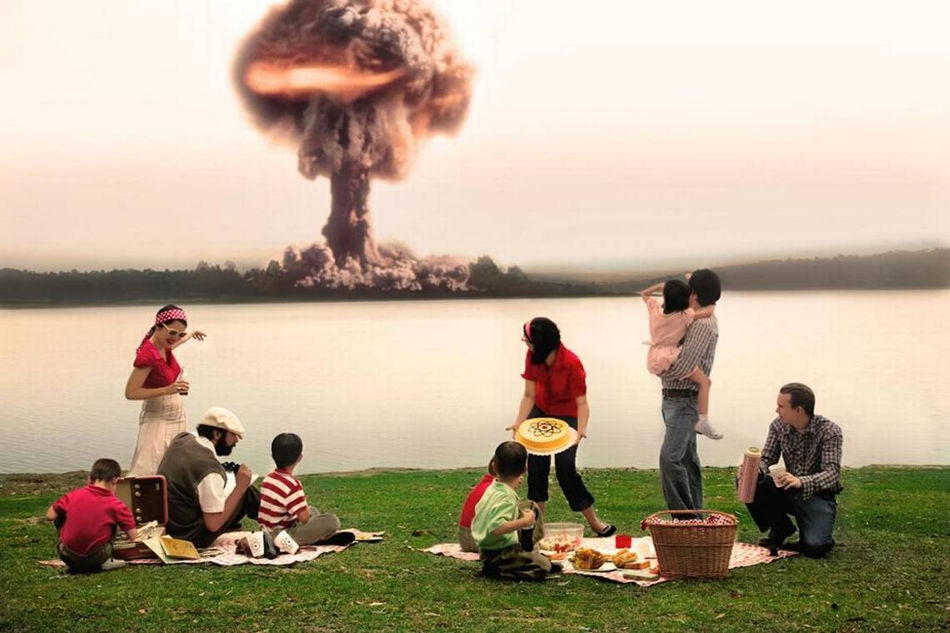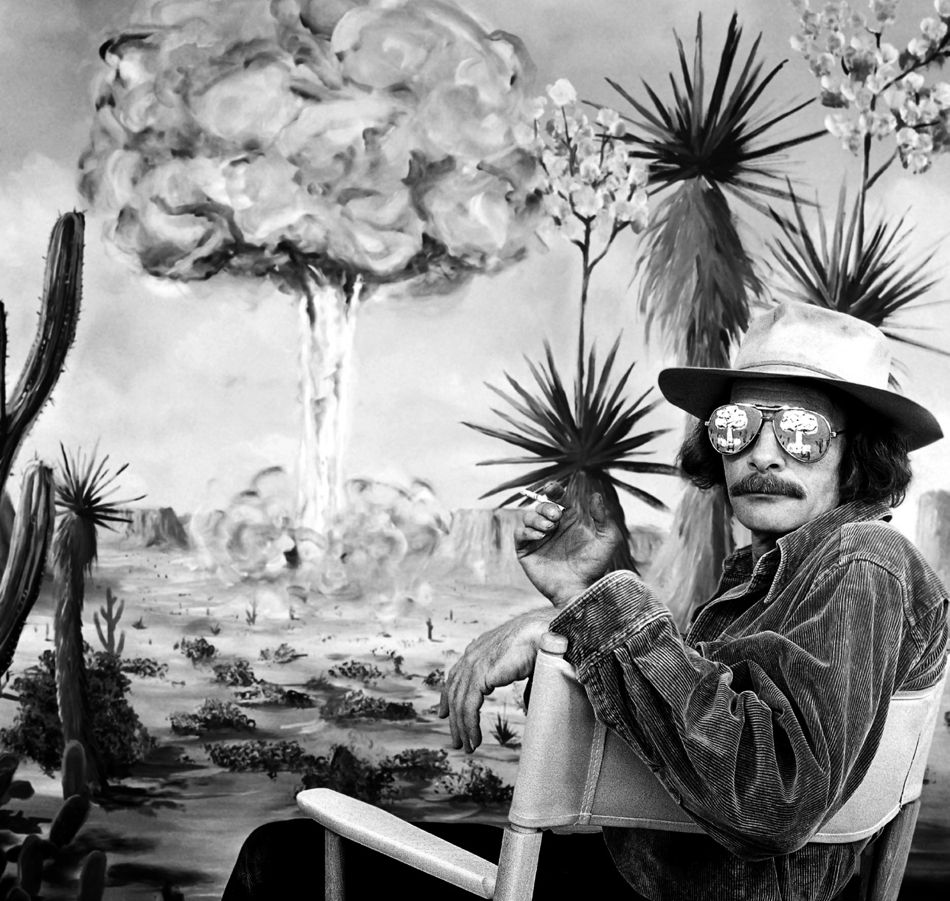The fighting in Ukraine, which is taking place in and around nuclear power plants, and the loose comments made by powerful men about nuclear weapons remind us of the great dangers we face, writes Vijay Prashad.

Daniela Edburg, Mexico, “Atomic Picnic,” 2007.
By Vijay Prashad
Tricontinental: Institute for Social Research
 On Feb. 27, Russian President Vladimir Putin met the Chief of the General Staff of the Russian Armed Forces Valery Gerasimov and the Russian Defence Minister Sergei Shoigu.
On Feb. 27, Russian President Vladimir Putin met the Chief of the General Staff of the Russian Armed Forces Valery Gerasimov and the Russian Defence Minister Sergei Shoigu.
“The top officials of the leading NATO [North Atlantic Treaty Organisation] countries have made aggressive statements against our country,” Putin said. Therefore, he told his top officials “to transfer the deterrence forces of the Russian army to a special mode of combat duty.”
The last phrase, reasonably cloaked in bureaucratic language, means that Russia’s nuclear arsenal will move to high alert. Meanwhile, Russian forces appeared to have seized the Zaporizhzhia nuclear power plant in Ukraine, the largest nuclear power plant in Europe. Early reports that the power plant was on fire were false, although it was sufficiently chilling to hear that there had been fighting at the site.
More than 90 percent of the world’s 12,700 nuclear weapons are owned by the United States and Russia; the rest are found in seven other countries. About 2,000 of these warheads – held by the U.S., Russia, Britain and France – are on perpetual high alert, which means that they are ready to be used at a moment’s notice. The United States has stationed nuclear weapons not only on its own territory but across the world, including in Europe; roughly 100 of its B61 nuclear gravity bombs are based in Belgium, Germany, Italy, the Netherlands and Turkey – all NATO member states.
In 2018-19, the United States unilaterally withdrew from the 1987 Intermediate-Range Nuclear Forces (INF) Treaty, an arms control agreement with Russia, which promptly followed suit. The abandonment of the treaty means that each country can now deploy ground-launched missiles with a range of up to 5,500 kilometres, seriously weakening the security architecture in and around Europe.
It is undeniable that the INF withdrawal is part of the reason why the Russians believe that the United States seeks proximity to its borders in order to deploy such missiles and reduce the strike time to Russian cities. On top of this, the United States is building a new $100 billion missile system called the GBSD (ground-based strategic deterrent) that can travel nearly 10,000 kilometres; this missile can carry nuclear weapons and strike any place on the planet in minutes.

Elliott McDowell, U.S., “Tony at Yucca Flats,” 1982.
These dangerous developments – the withdrawal from the INF, the development of the GBSD, Russia’s invasion of Ukraine – came after the world voted “yes” on the Treaty on the Prohibition of Nuclear Weapons (2017) which went into force on Jan. 22, 2021. An overwhelming number of United Nations member states, 122, voted in favor of this treaty; only one member (the Netherlands) voted against it. However, 69 countries abstained, including all nine of the nuclear weapons states and all NATO members (except the Netherlands). The Russian military action in Ukraine is a reminder, at the very least, of why a global nuclear weapons ban is necessary, and why every single country must commit to disarming and disposing of its nuclear weapons arsenal.
There is a practical method to take the global desire for the abolition of nuclear weapons forward: the expansion of the Nuclear-Weapons-Free Zones (NWFZ).

Maria Prymachenko, Ukraine, “May That Nuclear War Be Cursed!,” 1978.
Since the early 1960s, Mexico’s representative to the United Nations, Alfonso García Robles, led the fight to develop a NWFZ in the Americas. If these regional zones are created and expanded, García Robles said at the U.N. in 1974, eventually the area “from which nuclear weapons are prohibited [will reach] a point where the territories of Powers which possess those terrible weapons of mass destruction will become something like contaminated islets subject to quarantine.”
García Robles spoke with the prestige afforded to Mexico for its leadership in passing the Treaty of Tlatelolco in 1967. This treaty created the first NWFZ, which included 33 of the 35 countries of the American hemisphere; only Canada and the United States remained outside the zone.
Four other NWFZs have been created since the Treaty of Tlatelolco: in the South Pacific (Treaty of Rarotonga, 1985), in Southeast Asia (Treaty of Bangkok, 1995), on the African continent (Treaty of Pelindaba, 1996), and in Central Asia (Treaty of Semipalatinsk, 2006). Together, these five NWFZs include 113 countries, comprising 60 percent of the member states of the United Nations and every country on the African continent.
The main legal agreements related to nuclear weapons, such as the Treaty on the Non-Proliferation of Nuclear Weapons (NPT, 1968), allow for the establishment of these Nuclear-Weapons-Free Zones; for example, article VII of the NPT states, “Nothing in this Treaty affects the right of any group of States to conclude regional treaties in order to assure the total absence of nuclear weapons in their respective territories.”
The U.N. General Assembly has regularly called for the establishment of additional NWFZs.

Pavel Pepperstein, Russia, “Bikini 47,” 2001.
None of the nuclear weapons states have joined these treaties. This is not from lack of interest. In 1966, Soviet Premier Alexei Kosygin told the U.N.’s Disarmament Committee that his government was willing to include a clause into the NPT that would prohibit “the use of nuclear weapons against non-nuclear States parties to the treaty which have no nuclear weapons in their territory.”
The next year, the Soviet Ambassador to the Disarmament Committee Alexei Roshchin said that his government hoped that the NPT should be considered as a “first step towards the cessation of the nuclear arms race, towards the elimination of nuclear weapons.”
These sentiments from Kosygin and Roshchin followed the plan that was proposed to the United Nations by Polish Foreign Minister Adam Rapacki on Oct. 2, 1957, for the creation of a denuclearized central Europe.
The Rapacki Plan suggested that a NWFZ be established in Poland and the two Germanys, with the hope that it be extended into Czechoslovakia. The plan was supported by the Soviet Union, along with all the countries of the Warsaw Pact (Albania, Poland, Czechoslovakia, Hungary, Bulgaria, Romania and the German Democratic Republic).
Objection to the Rapacki Plan came from NATO and in particular from the United States. At the Paris meeting of the NATO council in December 1957, the military alliance decided to continue their nuclear weapons build-up, arguing that the Soviet Union would wield an advantage over European countries relying on “arms of the preatomic age.”
Two weeks later, the Polish Foreign Ministry discussed NATO’s decision and formulated a reasonable response toward the creation of a second draft of the Rapacki Plan. The four new elements of the plan included:
- To guarantee that the nuclear-free zone would not be attacked by nuclear weapons.
- To be prepared to reduce and balance conventional armed forces.
- To develop a control plan in the zone for all types of weapons.
- To develop a legal form for a nuclear-free zone treaty.
NATO would not take any of these proposals seriously. The Rapacki Plan died a quiet death and has been largely forgotten. Today, there is no discussion about a Nuclear-Weapons-Free Zone in any part of Europe even though it is ground zero for the nuclear trigger.

Faiza Butt, Pakistan, “Get Out of My Dreams I,” 2008.
Suggestions for Nuclear-Weapons-Free Zones for other parts of the world abound. Iran has been one of the proponents for a NWFZ in the Middle East. This was first raised at the U.N. in 1974 and was proposed in the U.N. General Assembly by Egypt and Iran each year from 1980 to 2018 and is adopted each year without a vote. But that proposal has been dead in the water because Israel refuses to accept it.
In September 1972, Pakistan’s representative to the U.N. Atomic Energy Conference Munir Ahmad Khan proposed a NWFZ in South Asia, but the idea was set aside when India tested nuclear weapons in May 1974. Here and there, countries raise the issue of an Arctic NWFZ or a Pacific Ocean NWFZ, but none of these have come to pass. The main adversaries to these proposals are the nuclear weapons states, with the United States in the lead.

Akiko Takakura, Japan, “A Woman Driven by Unbearable Thirst Tried to Catch the Black Raindrops in Her Mouth,” c. 1974.
The fighting in Ukraine which is taking place in and around nuclear power plants and the loose comments made by powerful men about nuclear weapons remind us of the great dangers we face.
When I was a child, Indian schools commemorated Hiroshima Day on August 6 with great solemnity. Our school was given a lecture about the brutality and then we went to our classes and either made a drawing or wrote a story about what we had learned. The point of the exercise was to imprint a great hatred for war in our young minds. It strikes me that we – as a human civilization – have forgotten about Hiroshima and Nagasaki and the terrible weapons dropped upon their populations by the United States in 1945.
I have spent years reading the words of the hibakusha, the survivors of those attacks, and re-reading the journalism of Wilfred Burchett, John Hersey and Charles Loeb and the writings of Kenzabur? ?e, K?b? Abe, Masuji Ibuse, Michihiko Hachiya, Sankichi T?ge, Shinoe Sh?da, Tamiki Hara, Y?ko ?ta, Yoshie Hotta and others. These writers illuminate the terror of war and the amnesia inflicted on the world by those who want to continue to drag us into conflict after conflict.
In this reading, I encountered the exchange between Günther Anders, a German Marxist philosopher, and Claude Eatherly, one of the U.S. pilots who flew as part of the squadron that bombed Hiroshima. Anders wrote to Eatherly in 1959, beginning a correspondence that resulted in a broken Eatherly writing for forgiveness to the people of Hiroshima. The response from 30 young hibakusha women to Eatherly moved me deeply, as I hope it will move you too:
We have learned to feel towards you a fellow-feeling,
thinking that you are also a victim of war
like us.
It is as if the hibakusha women were channeling the sentiments that first created International Working Women’s Day over a hundred years ago, a day which, in 1917, was the spur to the revolution in Tsarist Russia. Of war and its divisions, one of the day’s founders Clara Zetkin wrote:
“The blood of the killed and the wounded must not be a stream to divide that which unites the present distress and the future hope.”
Vijay Prashad, an Indian historian, journalist and commentator, is the executive director of Tricontinental: Institute for Social Research and the chief editor of Left Word Books.
This article is from Tricontinental: Institute for Social Research.
The views expressed are solely those of the author and may or may not reflect those of Consortium News.

The brilliant mind should want no part of babysitting nuclear weapons. Only the freak, the certifiably insane would seek such responsibility. I suspect the brilliant mind would fail in such a situation, that of ensuring that the most individually expensive weapons on earth are not used.
This waste is epic failure of humans to control themselves and the U.S.A. led the way. The nuclear deterrent was severely damaged when the U.S. some how was convinced to allow the surreptitious transfer of Special Nuclear Materials to Israel. Which was happening around the time JFK was killed. His death signaled the end of early efforts to limit nuclear proliferation. Thj plan to walk back efforts on nuclear weapons died with him.
Much like the Ukraine problems we have today could have been handled differently the same has been said about nuclear proliferation.
Cuba, Hiroshima and Nagasaki taught world leaders damned little that could out strip their fear of the Soviet and U.S. rush to arm themselves with nukes, not out of fear but out of lust for power.
It has been said the the mad man has no fear. I say they prove it every day.
Once again leadership had miserably failed us by allowing themselves to turn their heads rather than stop a murder. One must ask themselves why that happened.
Thank you Vijay Prashad & CN Crew
While normal people agree whole-heartedly with these sentiments, our government is not comprised of normal or honorable men.
The US only honors treaties/ agreement when it’s in their interest to do so.
We are looking at War in Ukraine which could have easily been prevented if only Biden had let Zelinsky honor Ukraine’s signature on the Minsk II Accords.
Nuclear War is an all or nothing escalating exercise (although Robert Scheer recounted G.W.H. Bush claiming a nuclear war was winnable, a view surely shared by the deranged neocon/ neolibs in DC today.)
A much more likely danger is bioweapons, as in the 30 labs taken out by Russians in Ukraine. SARS-CoV2 was likely the result of a lab accident, but all major states are capable of much, much worse.
Eatherly and those 30 women have everything to teach us.